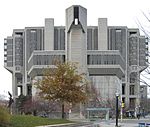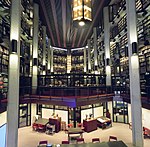Cheng Yu Tung East Asian Library

The Cheng Yu Tung East Asian Library (Chinese: 鄭裕彤東亞圖書館) is a Canadian library and a part of the University of Toronto Libraries system. Located on the 8th floor of the Robarts Library at the University of Toronto's St. George campus, it is a major research collection on East Asian Studies in North America with over 660,000 volumes. The Library is open to the general public. The Library began with a collection of rare materials acquired from China in the 1930s. This special collection is now known as the Mu Collection (慕氏藏書). Extensive additional materials in Chinese, Japanese, Korean, Tibetan and Mongolian have been added over the years. The Library organizes about 10-15 events annually, promoting East Asian Studies/Asian Canadian Studies through collaborative partnerships with campus units and various external organizations.
Excerpt from the Wikipedia article Cheng Yu Tung East Asian Library (License: CC BY-SA 3.0, Authors, Images).Cheng Yu Tung East Asian Library
Helga and Mike Schmidt Performace Terrace, Toronto
Geographical coordinates (GPS) Address Website Nearby Places Show on map
Geographical coordinates (GPS)
| Latitude | Longitude |
|---|---|
| N 43.664444444444 ° | E -79.399444444444 ° |
Address
University of Toronto (University of Toronto - St. George Campus)
Helga and Mike Schmidt Performace Terrace
M5S 2E5 Toronto
Ontario, Canada
Open on Google Maps






